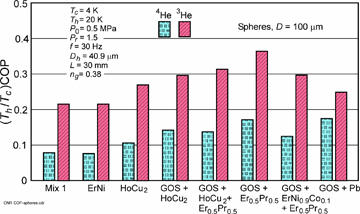Summary
The Cryogenic Technologies Project has been funded by ONR since FY2005 to measure and model the losses in 4 K regenerators and pulse tubes. These thermal components are part of 4 K cryocoolers to be used for the cooling of superconducting electronics required by the military for the development of all-digital radio communication between the various military forces. The efficiency of existing 4 K cryocoolers is only about 0.8 % of Carnot, which means about 1 kW of input power is required to provide only 0.1 W of net refrigeration at 4 K. ONR has asked NIST to measure and model the losses in the 4 K regenerative heat exchanger (regenerator) and in the 4 K pulse tube component to help cryocooler manufacturers find ways to increase the efficiency of 4 K cryocoolers.
Description
All-digital radio communication between the various forces of the U.S. military is required to improve communications to the level needed in the near future. Such communication requires analog-to-digital converters of speeds only possible with low temperature superconducting electronics. The replacement of existing rack-mounted rf electronic communication equipment with superconducting digital equipment requires the development of compact 4 K cryocoolers that can provide about 0.1 W of refrigeration at 4 K with much less than 1 kW of input power. Existing 4 K cryocoolers require at least 1 kW of input power and are too large and heavy for military operation. We have determined that major sources of entropy generation in such cryocoolers are those in the 4 K regenerative heat exchanger (regenerator) and the 4 K pulse tube component. The real-gas effect in the 4He working fluid is also a major source of loss in these 4 K cryocoolers. The objective of this program is to determine how to increase the efficiency of the 4 K stage by a factor of about four while still being able to operate at a relatively high frequency of 30 Hz so that the compressor can be made compact.
Goals of the program are (a) to develop accurate equations for transport properties for 3He from 4 K to 300 K and to high pressures (at least 2.5 MPa), (b) incorporate these 3He equations along with equation of state for 3He in a new numerical computer code (REGEN3.3) that models the behavior of regenerators down to 4 K using either 3He or 4He, (c) use the model to determine optimum operating conditions and regenerator materials, (d) develop an apparatus that can separate and measure various losses in 4 K regenerators and pulse tubes, (e) measure losses in 4 K regenerators and pulse tubes and compare with model predictions, and (f) modify the model where appropriate.
Activities to date in the program are the development of the equations for the viscosity, thermal conductivity, and surface tension for 3He from 0.003 K to 1000 K and for pressures from 0 to 20 MPa. A Debye equation of state for similar temperatures and pressures was developed at Zhejiang University in China, and in collaboration with them both the equation of state and the transport equations were incorporated into the new NIST software known as REGEN3.3. This software follows from early NIST software for modeling the behavior of regenerators, but incorporates the 3He properties as well as those of 4He and includes improved numerical procedures to decrease the running time by a factor of ten or more (minutes instead of hours). The software was made publicly available in March 2008 on the NIST website. The new software was used to find the optimum operating conditions for both 3He and 4He working gases as well as the optimum regenerator materials. Figure 1 shows the 2nd law efficiency of the 4 K regenerator with various regenerator materials using 3He and 4He working gases. A factor of four to five efficiency improvement is indicated when using 3He and the optimum material combination. Figure 2 shows the apparatus constructed to measure losses in regenerators and pulse tubes at temperatures down to 4 K.

Major Accomplishments
- Develop equations for transport properties of 3He from 0.003 K to 1000 K.
- Develop regenerator numerical software code with 3He and 4He properties.
- Determine optimum operating conditions and optimum regenerator materials.
- Develop apparatus to measure regenerator and pulse tube losses.

